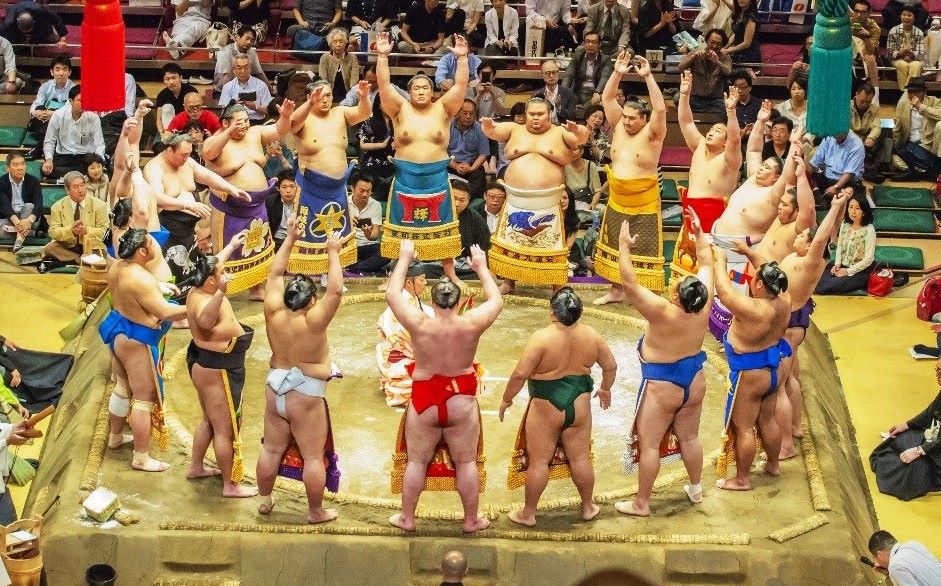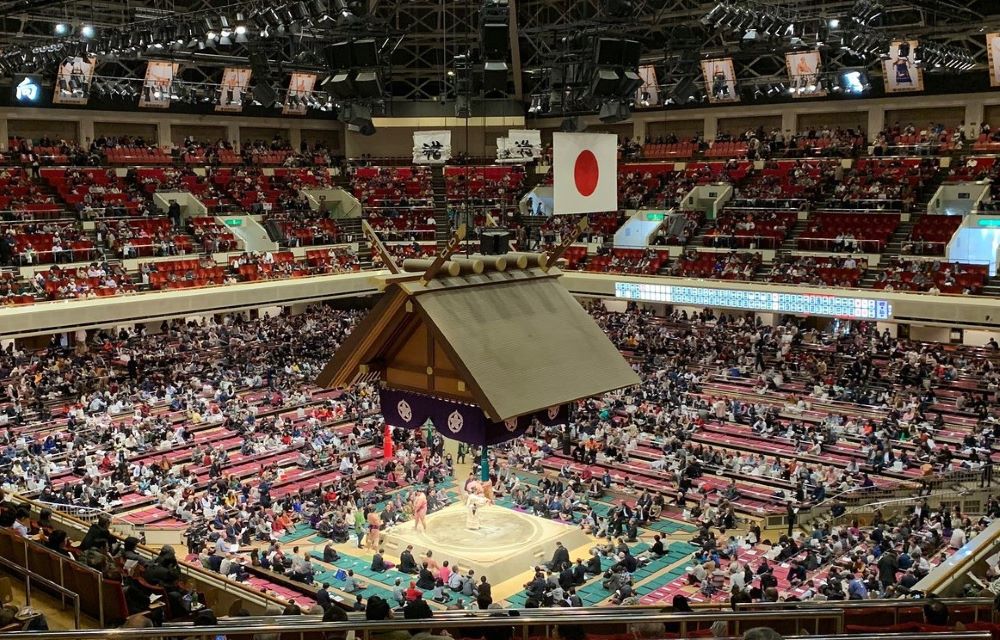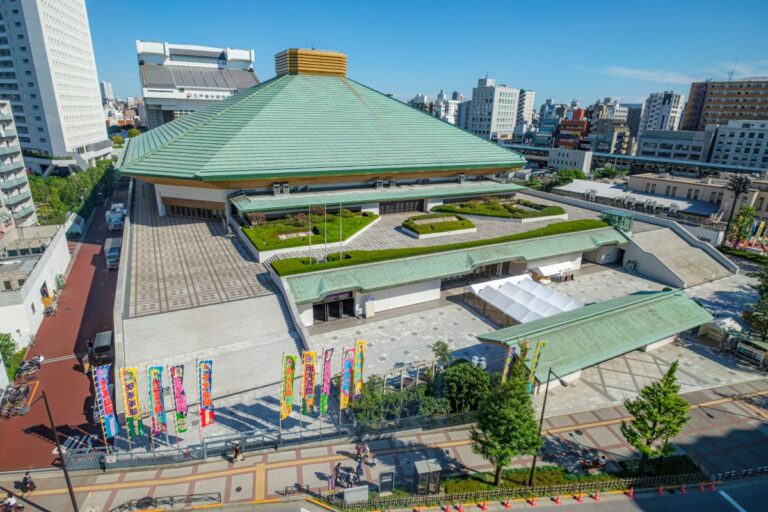Sumo is a centuries-old Japanese sport that has captured the world’s attention with its unique blend of athleticism, tradition, and pageantry. Sumo Grand Tournaments are the pinnacle of this sport, featuring the best wrestlers from around the world competing in a series of matches over 15 days.

These tournaments are steeped in history and ritual, and understanding their intricacies is essential for any true sumo fan.
In this in-depth guide we’ll give you everything you need to know about Japan’s Graand Sumo Grand Tournaments including schedules, locations, how to get tickets and of course how to watch these unique spectacles.
Key Takeaways
- Sumo Grand Tournaments take place over 15 days and feature 6 matches per day for each wrestler.
- Tokyo has 3 Tournaments in January, May and September.
- Tokyo’s tounaments ar at Kokugikan Stadium.
- Tickes start at around 2,200 yen and go up to 38,000 yen
- If you miss the tounarment you can also watch sumo morning practice whic you can book as a tour
History of Sumo Grand Tournaments

Sumo is a traditional Japanese sport that has been around for centuries. The first recorded Sumo match was in 23 BC, and the sport has been an important part of Japanese culture ever since. Sumo Grand Tournaments, also known as Honbasho, are the most prestigious events in the sport, attracting thousands of spectators from around the world.
Origins of Sumo Tournaments
The first Sumo matches were held as religious ceremonies, with wrestlers competing to honor the gods and protect their villages from harm. Over time, Sumo evolved into a more formalized sport with specific rules and regulations. The first Sumo tournament was held in 1684, during the Edo period, and it was organized by the Shogun Tokugawa Yoshimune. The tournament was held to raise money for the construction of a new shrine, and it was a huge success.
Evolution of Tournaments
Since the first Sumo tournament, the sport has undergone many changes. The modern Sumo Grand Tournaments consist of 15 days of competition, with wrestlers facing off against each other in a single-elimination format. The tournament is held six times a year, with three tournaments taking place in Tokyo, and one each in Osaka, Nagoya, and Fukuoka.
Each tournament has six divisions, with the top division being the Makuuchi division. The wrestlers in this division are the best in the sport, and they compete for the title of Yokozuna, the highest rank in Sumo. The Yokozuna is considered to be a living legend, and only a few wrestlers have ever achieved this rank.
Over the years, Sumo Grand Tournaments have become more than just a sporting event. They are a cultural phenomenon that attracts tourists from around the world. The tournaments are steeped in tradition, with wrestlers performing rituals before each match and wearing traditional clothing. The atmosphere is electric, with fans cheering on their favorite wrestlers and enjoying traditional Japanese food and drink.
Tournament Schedule
The Sumo Grand Tournaments are held six times a year, with each tournament lasting for 15 days. The tournaments take place in locations throughout Japan, with three of them being held in Tokyo and the other three held in Osaka, Nagoya, and Fukuoka. The tournament schedule is as follows:
| Tournament | Location | Dates |
|---|---|---|
| January | Tokyo | Second Sunday to Third Sunday of January |
| March | Oosaka | Second Sunday to Third Sunday of March |
| May | Tokyo | Second Sunday to Third Sunday of May |
| July | Nagoya | Second Sunday to Third Sunday of July |
| September | Tokyo | Second Sunday to Third Sunday of September |
| November | Fukuoka | Second Sunday to Third Sunday of November |
The tournaments start on a Sunday and end on a Sunday, with each day consisting of matches. The first week of the tournament is known as the “first half”, while the second week is known as the “second half”. The final day of the tournament is known as “senshuraku”, which is the most exciting day of the tournament as it determines the winner of the tournament.
Doors usually open around 8:00 am, with the lower-ranked wrestlers starting their matches at around 8:30 am. The higher-ranked wrestlers begin their matches around 3:30 pm. The final match of the day, featuring the two highest-ranked wrestlers, usually takes place at around 6:00 pm.
tickets for the Sumo Grand Tournaments sell out quickly, especially for the tournaments held in Tokyo. purchase tickets in advance to ensure a spot at the tournament.
Venue and Ticket Information

The Sumo Grand Tournaments in Tokyo are held at Kokugikan, a stadium in the Ryogoku district of Tokyo. The stadium has a capacity of 11,098 seats and is the perfect place to experience the excitement of Sumo wrestling.
There are three Sumo Grand Tournaments held in Tokyo each year: one in January, another in May, and the final tournament in September. The tournaments last for 15 days, and each day features matches. The matches start early in the morning and continue until the late afternoon.
Tickets for the Sumo Grand Tournaments can be purchased online or at the stadium. purchase tickets in advance, as they tend to sell out quickly. The price of the tickets varies depending on the seating area and the day of the tournament. The cheapest tickets start at around 2,200 yen, while the most expensive tickets can cost up to 38,000 yen.
There are types of seating areas available at the Kokugikan stadium. The most popular seating area is the Arena Box, which is on the first floor and gives you a close-up view of the matches. The next popular seating area is the Masu Box, which is on the second floor and gives you a more traditional Japanese-style seating experience. There are also regular seats available on the second floor, which are the cheapest option.
There are food and drink stalls inside the stadium where you can purchase snacks and drinks. It is also recommended to bring a cushion or a small pillow to sit on, as the matches can last for hours.
Rules and Regulations
Basic Rules of Sumo
Sumo is a sport where two wrestlers, or rikishi, face off in a circular ring called a dohyo. The objective is to force the opponent out of the ring or make any part of their body other than the soles of their feet touch the ground. Matches typically last only a few seconds, but can sometimes go on for minutes. Before the match begins, the wrestlers perform a ritual called shiko, where they stomp their feet to drive away evil spirits. They then enter the ring and squat down in a crouching position, called a tachiai. The match begins when both wrestlers touch the ground with their fists.
Scoring System
There are two ways to win a sumo match: either by forcing the opponent out of the ring, or by making any part of their body other than the soles of their feet touch the ground. If both wrestlers touch the ground at the same time, the match is declared a draw and a rematch is held. In addition to wins and losses, wrestlers are also awarded points based on their performance in each tournament. The wrestler with the most wins at the end of the tournament is declared the champion.
Fouls and Disqualifications
Sumo has a number of rules and regulations that wrestlers must adhere to during matches. Some of the most common fouls include stepping outside of the ring, grabbing the opponent’s hair, or using any technique that is considered dangerous or unsportsmanlike. If a wrestler commits a foul, they are immediately disqualified from the match. In some cases, they may also be fined or suspended from future tournaments.
Rankings and Divisions

Makuuchi Division
The Makuuchi Division is the highest division in Sumo wrestling. It consists of 42 wrestlers, with the Yokozuna (Grand Champion) being the highest rank. The Yokozuna is followed by the Ozeki (Champion) and then the Sekiwake (Junior Champion) and Komusubi (Small Sandal) ranks. The rest of the wrestlers are called Maegashira and are numbered from one to seventeen.
The wrestlers in the Makuuchi Division compete in a round-robin tournament format, with each wrestler facing every other wrestler in the division once over the course of 15 days. The wrestler with the most wins at the end of the tournament is the winner of the tournament.
Juryo Division
The Juryo Division is the second-highest division in Sumo wrestling. It consists of 28 wrestlers, with the highest-ranked wrestler being called the Juryo Yokozuna. The rest of the wrestlers are numbered from one to 14 and are called Juryo Rikishi.
Wrestlers in the Juryo Division also compete in a round-robin tournament format, with each wrestler facing every other wrestler in the division once over the course of 15 days. The wrestler with the most wins at the end of the tournament is the winner of the tournament.
Lower Divisions
Below the Juryo Division are the lower divisions, which consist of wrestlers ranked from Makushita to Jonokuchi. These divisions are also divided into sub-divisions, with each sub-division consisting of around 28 wrestlers.
Wrestlers in the lower divisions also compete in a round-robin tournament format, with each wrestler facing every other wrestler in their sub-division once over the course of 15 days. The wrestler with the most wins at the end of the tournament is promoted to the next-highest division, while the wrestler with the fewest wins is demoted to the next-lower division.
Famous Sumo Wrestlers
Historical Wrestlers
Sumo wrestling has a rich history dating back over 1,500 years. Throughout that time, there have been many legendary sumo wrestlers who have become household names in Japan and around the world. One such wrestler was Raiden Tameemon, who was active during the late 18th century. He was known for his immense strength and size, and was said to have once lifted a 1000-pound stone.
Another famous wrestler from the early days of sumo was Akashi Shiganosuke, who was active in the late 17th century. He was known for his incredible agility and quickness, and was said to be able to move so fast that he could dodge bullets.
Recent Top Wrestlers
Sumo wrestling is still a popular sport in Japan today, and there are many top wrestlers who are currently active in the sport. One such wrestler is Hakuho Sho, who is widely considered to be one of the greatest sumo wrestlers of all time. He has won a record 44 championships, and is known for his incredible strength and technique.
Another top wrestler is Kakuryu Rikisaburo, who has won six championships during his career. He is known for his quickness and agility, and is considered to be one of the most technically skilled wrestlers in the sport.
Other notable wrestlers include Takakeisho Mitsunobu, who is known for his powerful pushing technique, and Asanoyama Hideki, who is known for his well-rounded skills and ability to adapt to different opponents.
Training and Lifestyle of Sumo Wrestlers

Sumo wrestling is not just a sport, it’s a way of life. Sumo wrestlers live and breathe their sport, dedicating themselves to a rigorous training regimen and strict lifestyle. In this section, we’ll take a closer look at the training and lifestyle of sumo wrestlers.
Training Regimen
Sumo wrestlers train for hours each day, starting early in the morning. Their training regimen includes exercises such as weightlifting, cardio, and stretching. They also practice specific sumo techniques, including pushing, pulling, and throwing their opponents. Sumo wrestlers also engage in sparring matches with other wrestlers to improve their skills and technique.
One unique aspect of sumo training is the use of a “dohyo,” a raised clay platform where wrestlers practice their moves. The dohyo is considered sacred and is only used for sumo training and matches.
How to Watch Sumo Training in Tokyo

If you’re interested in watching sumo wrestlers train, you can visit a sumo stable in Tokyo. Sumo stables are where wrestlers live and train together, and visitors are welcome to watch their training sessions. You can find a list of sumo stables that allow visitors on the Japan Sumo Association’s website.
When visiting a sumo stable, it’s important to be respectful and follow the rules. Visitors are expected to sit quietly and not disrupt the training session. It’s also customary to bring a small gift, such as a box of sweets, as a token of appreciation.
More: How To Watch Sumo Training Practice In Tokyo
Diet and Nutrition
Sumo wrestlers follow a strict diet to maintain their large size and strength. They consume a high-calorie diet of protein and carbohydrates, often eating up to 10,000 calories per day. Their diet includes traditional Japanese foods such as chankonabe, a hot pot dish made with meat, fish, and vegetables.
Despite their high-calorie intake, sumo wrestlers are also careful about their nutrition. They avoid foods that are high in fat and sugar and focus on eating lean protein and complex carbohydrates. They also drink lots of water to stay hydrated during their intense training sessions.
The Sum Up
Sumo Grand Tournaments are a must-see event for anyone visiting Japan. The tournaments offer a unique insight into Japan’s traditional sport and culture. With six tournaments held each year, there are plenty of opportunities to experience the excitement of Sumo.
During the tournaments, you can witness the intense battles between the wrestlers, experience the atmosphere of the arena, and learn about the history and traditions of Sumo. With tickets available at price points, there is an option for everyone, from the budget-conscious to the luxury traveler.
While the tournaments are the main attraction, you can also explore the surrounding area and enjoy the local food and drink. Tokyo, in particular, offers a wealth of activities and sights to see, making it the perfect destination for Sumo fans and non-fans alike.
Overall, Sumo Grand Tournaments are a fascinating and unique experience that should not be missed. Whether you are a sports enthusiast or just looking for a new cultural experience, a trip to a Sumo tournament is sure to be a highlight of any trip to Japan.






